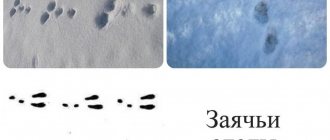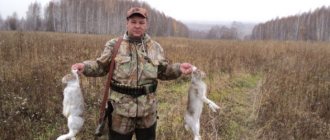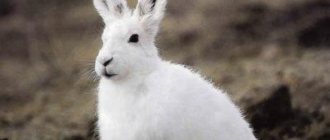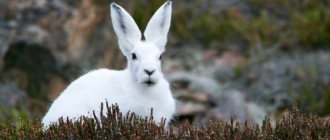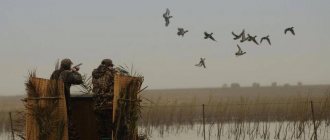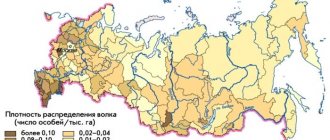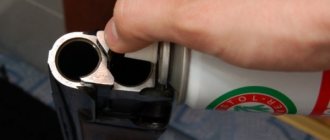Trying hare meat, sewing excellent white mittens or simple sporting interests - these and other goals guide avid hunters. But do not think that the hare will wait under the nearest pine tree and calmly allow itself to be found. On the contrary, these animals have extremely acute vision, capable of catching the most imperceptible movements of their pursuers, and a pair of fast paws. So hunting hares is not only an exciting activity, but also quite difficult.
Fortunately, numerous generations of hunters of these eared creatures also did not waste time and managed to invent a single effective way of hunting hares. In this article we will look at several methods of hunting without a dog.
One of the most popular is hunting by drive, that is, collectively.
Collective driven hunt
To hunt hares using the driven method, the brigade is divided into two groups: beaters and shooters. The first ones pass by the hare's beds with the maximum possible noise, tapping with sticks, twirling rattles with a loud cry. In this case, frightened hares rise from their beds and run straight to the numbers.
Hunting a hare in a chain a - chain; b - forest chain; c - chain with flanks; 1 - beater; 2 - shooter; 3 - hunt leader
It is best to hunt in this way in frosty autumn weather along the black trail: then the long-eared comrades sit very sensitively, ready to instantly leave their settled place - a feeding swamp, for example. But in warmer weather, white hares (they are hunted in early winter) are difficult to lift, and no amount of ratcheting will help.
In the midst of winter, hunters switch to hare, which like to make themselves comfortable somewhere in bushes, ditches overgrown with grass, or among stones. In such places it is quite easy to notice the danger. Having attacked the hare's trail, and making sure that the tracks do not go beyond the shelter, the shooters and beaters surround the hare's shelter and take opposite positions. Well, then everything happens according to the old scheme.
Circular pen 1 - beater; 2 - shooter; 3 - hunt leader
They say, by the way, that the hare is very fast, while his white relative (phlegmatic, apparently by temperament), in absolutely no hurry, runs out right in front of the shooters, which they take advantage of. However, even not very smart hare can leave you with your nose if the hunters do not move in an organized manner, and “holes” appear in their chain through which the prey finds a way to escape. This occurs due to ignorance of the basic rules of behavior in a chain: navigate by the rear neighbor in the group, the distance between hunters should be no more than 60–70 meters, and so on.
Hunting alone can be done in several ways: from the approach and from ambush.
Hunting in autumn
In the autumn months the weather is still favorable. Hares live in tall thickets, in bushes near water bodies, and on forest edges.
Let's consider the best ways for an interesting hunt.
Out of hiding
The option is suitable for late autumn. A place of shelter for a hunter is a straw haystack, farmland with crop remains, a broken garden with a storage shed. The hare goes to such places to eat.
When choosing the method of hiding, you need to set up a storage room in the evening for a long pastime. Then go hunting into the night.
It's nice if the area is lit. So it’s not difficult to notice an approaching animal. And when he gets closer, shoot accurately. If you do everything correctly, you can quickly catch a trophy.
A semi-automatic gun with 12 and 20 gauge cartridges is suitable for the gun. You need to shoot the hare at the feet. It is unlikely that a long-eared animal will run more than 400 m when wounded. This means that it will not be difficult to find prey.
Hare hunting in autumn from the approach
The hunter is trying to reveal the secret habitat of the animal, moving slowly. To increase the likelihood of success, it is better to choose wet weather and stand against the wind. Then the steps are not so audible. The oblique will not be able to detect human scent.
Hunting in a drive
The corral method requires the presence of several people. Each beater takes his place on the territory. He begins to run and make noise when he sees an animal, driving it towards the hunter who will shoot.
How to hunt a hare from the approach?
Typically, such hunting is carried out in the winter season, when snow has already fallen. For example, you can simply follow a hare's trail and then find its owner. This method is called “trapping” or hunting in the wild.
Traces of a hare to feeding and back
It is best to track hares after fresh snow falls at night (it is also called powder), and the later the snowfall ends, the less you will have to understand the intricacies of tracks in the forest.
Having reached the feeding site, you should not try to unravel the many “patterns” left by the hare, but simply try to find the exit trail by making a small circle with a diameter of 50–100 meters around the feeding site. Yes, and get ready for the fact that the cunning animal will certainly confuse its possible pursuers with jumps to the side and loops.
Sometimes, however, you can find “dead” powder, when only the freshest traces remain uncovered, and then the prey is somewhere very close.
However, even if this is not the case, the hunter, while following the trail, must look around and pay attention to all possible hiding places of the hare, and be always ready to shoot. Otherwise, the hunter simply will not notice the moment when the prey jumps out and snatches it from under his nose. Although failure should not embarrass the unlucky hunter: if hares do not often encounter hunters at the feeding site, the departed animal may return after a few hours.
Hunting from ambush in winter
Another interesting hunting method is called “blind hunting”. Try to hide somewhere in a haystack or barn located on the edge of the village.
Hares usually suffer from hunger in winter, and their appearance in a populated area at this time of year does not seem out of the ordinary. You can even feed them treats - cabbage and hay.
It is better to occupy the ambush site before sunset, and you need to dress very warmly, because you will have to wait for several hours. The secret is that spotting an animal at night with a full moon is not particularly difficult, but going hunting on a new moon, and even with a strong wind, is definitely not worth it. You still won’t be able to see anything, even if ten hares are fattening a few steps away from you. A good time for hunting is a clear night without wind or snow.
It is also necessary to distinguish the hare from its shadow, which may seem darker than its owner. In addition, make sure that in front of you is really the object of your hunt, so that in the heat of excitement you do not shoot a cat or dog. Then you yourself will burn out of frustration, and in addition you will have troubles with the owners.
How to shoot a hare correctly, see the photo selection; it is necessary to take into account the lead depending on the speed of movement and the range of the shot.
Shooting a hare
A short video about the main mistakes when shooting.
Equipment for hare hunting
For hunting you need the usual equipment: a gun, a bandoleer, cartridges with 3-0 shot, a hunting knife, a flashlight. Dress according to the season; if you are going hunting or you will be a beater, you need to dress more lightly than those who stand at the number. But also be prepared for the fact that it may rain in the fall; clothes should be waterproof. When hunting on a blind, you need to dress very warmly, since the nights in winter can be quite cold, and spending several hours in the cold in light clothing is still a pleasure.
If hunting is carried out in deep snow, skis are required; it is better if they are lined with camus to make it easier to overcome climbs. A light small backpack with hot tea and provisions for the day. The peculiarity of hunting is that it will be necessary to travel quite long distances in search of prey and you need to be prepared for this.
For orientation, it is better to have a GPS navigator, and be sure to take a compass with you, so as not to get into a situation where they start looking for you with the involvement of the Ministry of Emergency Situations.
I hope these tips will help you in hunting big-eared game. Hunt, develop your skills and sooner or later you will be called to hunt as an experienced hare hunter to learn from experience. All that remains is to wish you a successful hunt.
About
Hunting in Tatarstan
Autumn has arrived and the hare hunt has begun. Hunters with hounds are doing their best to hunt hare and fox. Hunters without dogs were much less fortunate. Firstly, not all hunting grounds give the right to hunt without dogs along the black trail. Secondly, hunting a hare along a black trail without a dog makes no sense, as many hunters (especially beginners) think. But there will always be people who will refute these dogmas.
I discovered this type of hunting for myself quite by accident, although in my youth in the village, having read Bianchi’s books with a neighbor, they chased russians through plowed fields, the so-called Uzerka hunting (but more on that later).
So, mid-October. Central part of Tatarstan. The main target is black grouse. On the first day I caught about 15 black grouse and at least one koscha!!! All are diggers; according to the unwritten hunting laws, we don’t shoot them. I systematically walk around promising places and suddenly pick up a hare. Alas, I don’t have a license in hand. We have been hunting in these places for 2 years now, but we have not seen a hare yet. Lucky! But next weekend we have a license in hand and there are 3 long days of holidays ahead! All promising places are marked on the Google map, the tactics have been chosen, all that remains is to check it. As a result, the right hunting areas and strategy made it possible to close the hunting license alone in 3 days and catch three hefty hare.
Now let’s learn more about the tactics and features of hare hunting in Tatarstan (when I say hare, I mean hare). Tatarstan is famous for its agriculture. Therefore, its large area in October consists of arable land, winter crops and fields with harvested corn, sunflowers and sometimes beets. Nowadays, agricultural workers are armed with powerful German machines, so the equipment does not linger much in the fields, which does not bother wild animals so much. Vast fields are separated by plantings and ravines; sometimes on the fields themselves there are isolated thickets of willow, stakes and unplowed areas with marshy areas. These are all places that interest us.
Habitat of the hare.
The first type is uncultivated land.
If for some reason agriculture in any hunting area does not flourish, there are much more places for the hare to lie down and hunting turns into hard work. Here, endurance and perseverance coupled with shuttle walking will bring success. Make the shuttle in increments of no more than 20-25 meters, because The hare usually sits firmly in the grass, can let the hunter pass, and quietly leave, so that you won’t even know about his presence, only if you accidentally stumble upon a bed. Usually we use the map to identify in advance places suitable for the hare to rest. Basically, these are small areas overgrown with willows, young birches, aspens and pine trees along the edges of large ravines. Along with the hare, black grouse also lives here.
A typical roosting place for a hare is in uncultivated fields.
It is worth noting that most of these hunts involve great physical exertion and often require walking 25 km in a short autumn day. over very rough terrain. because Not all interesting places are accessible by car. As I already said, having found the approximate location of the hare, we go into it against the wind and with a shuttle, grasping the edges of the thickets, we comb the area. In my tactics, I stop for 3-4 seconds every 50-60 meters, deliberately making the last 2 steps loud. This trick was suggested to me by Ilyas Abiy, a game manager at the Atkanysh hunting estate. True, in the original everything was exactly the opposite, i.e. In order not to frighten off the hare, you must not stop and, having reached the expected place of the hare’s resting place, you must mark time. I do the opposite on the black path, because... the goal is to “squeeze out” the tightly lying hare and lift it. At the same time, you must control 360 degrees around you and always be prepared for an unexpected rise.
I’ll say right away that despite the apparent difficulty of hunting in the first type of land and vast spaces, hunting here is most effective, especially for a lone hunter.
The second type of land is farmland.
In such areas, the hare chooses different places to lie down and can be found in conditions completely unexpected for the hunter. But still, the most characteristic stations are: forest plantations, stakes and edges of plowed fields overgrown with weeds, alfalfa and harvested corn fields, a roughly plowed field. It happens that a hare lies on the most plowed field near the remains of grass and in winter crops, which, due to the warm autumn, have risen to a height where a scythe can hide in them. Or it could be turnout in the field, the remains of last year's straw. In general, in such conditions the hare has somewhere to hide from the hunter. Therefore, for a successful hunt you will need a team. Only an experienced hunter can detect and outwit a hare alone. But beginners should not despair, patience and work will grind everything down! At the same time, you will have invaluable experience behind you.
Let's take a closer look at each case.
So, in front of you is a forest plantation separating 2 vast fields or planted along the edge of a ravine. The hare in the planting loves a thin “undercoat” of birch trees or young aspens. Particular attention should be paid to islands of tall grass. To comb this area with the greatest benefit, the effort of 3 hunters will be needed: two walk along the edge of the planting, one goes inside. There is no need to create much noise; a little tapping on tree trunks and periodic stopping of the beater will suffice. It is better for all participants in the hunt to walk on the same straight line.
Pegs in winter fields or arable land are the hare's favorite place to lie down. Here he manages to outwit the lone hunter in most cases. If the pegs are small, the effort of three hunters is enough: two stand so that there are no “dead” zones during shelling, the third enters the peg and pushes out the hare (often the fox also gets hit by shots). Some features of such a hunt. Firstly, don’t come closer than 30-40 meters to the peg! Secondly, two hunters walking along the edge should, as it were, capture the area “in pincers” so that the approach is at 90 degrees to the forest and stand opposite each other relative to the middle of the stake. Otherwise, a “dead” zone will form on one side, into which the hare can successfully sneak through. So, two hunters synchronously approach the edge of the fragment at 30 meters and give the command to the beater to enter. The hare can run out in any direction, so you need to be extremely careful. Thirdly, you should never get everyone together before the next paddock.
We do not forget about precautionary measures when hunting collectively, so under no circumstances do we shoot in the direction of the forest.
The edges of fields overgrown with weeds, or areas near them with small undergrowth of trees, can be searched by one hunter.
Alfalfa, harvested corn or sunflower fields, roughly plowed lands are suitable for combing by a large company; such areas are very difficult for one hunter to cover. Successful hunting can only be done on arable land “in the wild” when the hare has already turned white and the snow has not yet fallen or melted due to warm weather.
The fields with the Volzhanka type sprinkler , which some agricultural enterprises still have, stand apart What is especially interesting is that they “park” this “car” every year in the same place, which is overgrown with weeds and tall grass. “Parking” is a plot of uncultivated land from the center of the field to one of the edges and up to 4 meters wide. This is one of the most promising hare havens. Typically, “Volzhanka” equipped fields sown with beets, potatoes and other vegetables, which are a delicacy for the hare. Even after recycling these cars, sometimes there remains a “parking” lane. Don't pass these places!
The third type is abandoned gardens, holiday villages, outskirts of villages, abandoned farms, summer camps for grazing livestock.
Personally, I think these areas work better on the white trail, except for summer camps. At least in October it is much more difficult to raise a hare here, because... There are a great many places for a hare to hide here. These include weeds near farms, dachas and fences, and abandoned buildings, bushes, tanks, edges of silos, etc. and so on.
Near summer camps for grazing livestock, hunting for hare can be very productive. Typically, cows are returned back to farms before the beginning of October, leaving behind piles of silage, haylage, scattered forage, remains of grain crops, and pieces of rock salt. All this attracts hares from the immediate surroundings and during feeding time you can meet 3-5 hares here. They, of course, scatter in the morning, but only 1-2 hares remain to lie down. They often lie near feeders and fences. You can hunt either alone or with a group. If alone, I start from the edge of the nettle and wormwood thickets that usually surround the camp. Next, we spiral towards the middle. Be sure to walk along the perimeter of the fence and near the feeders.
So we looked at typical hare bedding areas and hunting tactics in them.
Some short conclusions:
1). We always go (try to go) against the wind!
2). Make stops for 2-3 seconds
3). When we see a lying hare, we mark time and under no circumstances stop!
4). We cover large areas by shuttle from edge to edge
5). We discuss in advance how the corral will work when hunting in stakes
6). Brightly colored caps or vests are great when hunting as a team, so you can see exactly where your colleague is standing or walking.
7). The hare rarely lies on the highest place, preferring slopes
How to shoot a hare?
For hare hunting, my friends and I usually equip cartridges with shot numbers 3 and 1. The first shot from a half-shot (cylinder) is a cartridge for short distances. Usually this is a cartridge with number 3 shot, without a wad container, and in some cases (where you have to shoot quickly and short, for example near farms and in gardens) - a dispersant. The second shot is a long-range cartridge: shot number 1 in a wad container.
The desired gun is light and well adjusted to the hunter.
How to take a lead on a hare.
To be continued.
Especially for www.tathunter.ru
Azat Khamidullin
Copying without permission is prohibited!
